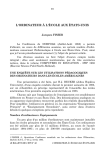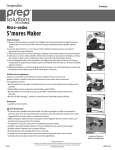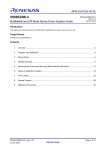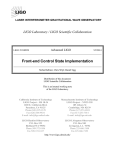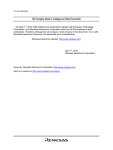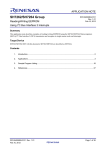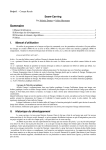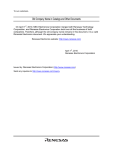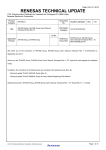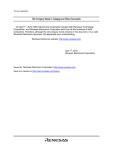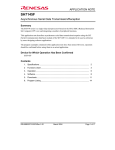Download SH7216 Group Accessing MultiMediaCard Using the Renesas
Transcript
APPLICATION NOTE
SH7216 Group
Accessing MultiMediaCard
R01AN0039EJ0100
Rev. 1.00
Aug. 27. 2010
Using the Renesas Serial Peripheral Interface
Introduction
This application note describes an example to access the MultiMediaCard (MMC) using the Renesas Serial Peripheral
Interface.
Target Device
SH7216
Contents
1.
Introduction........................................................................................................................................ 2
2.
Applications ....................................................................................................................................... 3
3.
Sample Program ............................................................................................................................. 15
4.
References ...................................................................................................................................... 24
R01AN0039EJ0100 Rev. 1.00
Aug. 27. 2010
Page 1 of 25
SH7216 Group
1.
Accessing MultiMediaCard
Using the Renesas Serial Peripheral Interface
Introduction
1.1
Specifications
This application accesses the MMC using the Renesas Serial Peripheral Interface.
1.2
Modules Used
• Renesas Serial Peripheral Interface
• Pin Function Controller
1.3
Applicable Conditions
MCU
Operating Frequency
Integrated Development
Environment
C Compiler
Compiler Options
MMC
1.4
SH7216
Internal clock: 200 MHz
Bus clock: 50 MHz
Peripheral clock: 50 MHz
AD clock: 50 MHz
Renesas Electronics
High-performance Embedded Workshop Ver.4.07.00
Renesas Electronics SuperH RISC engine Family
C/C++ compiler package Ver.9.03 Release 00
Default setting in the High-performance Embedded Workshop
(-cpu=sh2afpu -fpu=single -debug -gbr=auto -global_volatile=0 -opt_range=all
-infinite_loop=0 -del_vacant_loop=0 -struct_alloc=1)
Compliant with version 4.2
Note: MMC with version 4.3 or later does not support SPI mode.
Related Application Note
For more information, refer to the following application note:
• SH7216 Group Example of Initialization
1.5
About Active-low Pins (Signals)
The symbol "#" suffixed to the pin (or signal) names indicates that the pins (or signals) are active-low.
R01AN0039EJ0100 Rev. 1.00
Aug. 27. 2010
Page 2 of 25
SH7216 Group
2.
Accessing MultiMediaCard
Using the Renesas Serial Peripheral Interface
Applications
This application accesses the MMC using the Renesas Serial Peripheral Interface (RSPI). This section describes an
overview of the MMC protocols and the RSPI. For more information about the MMC protocols, refer to the MMC
specifications.
2.1
2.1.1
MMC Protocols Overview
SPI Mode
The MMC has two modes; MultiMediaCard mode (MMC mode) which is defined as its default operating mode, and
SPI mode which is based on the SPI standard. This application uses SPI mode. As this application note assumes that the
MMC is used in SPI mode, MMC mode is not described here.
2.1.2
Commands
Use the commands to access the MMC.
Figure 1 shows the command format. Fix bits start, host, and end to 0, 1, and 1, respectively. Set the command code as
the number which is included in the command name. Set an argument to the command parameter according to the
command. Set the CRC7 which is computed from 5 bytes including the command code and command parameter.
Start Host
End
Command
0 1
code
Command parameter
1 byte
4 bytes
CRC7
1
1 byte
CRC7 target data
Figure 1 Command Format
Table 1 lists major commands.
Table 1 Major Commands
Command
Code
CMD0
H'00
CMD1
H'01
CMD9
H'09
CMD10 H'0A
CMD12 H'0C
CMD13 H'0D
Name
Description
Name
Resets the MMC
Initializes the MMC
Reads the CSD register
Reads the CID register
Stops to read multiple blocks
Reads the Status register
CMD17
CMD18
CMD24
CMD25
CMD58
CMD59
R01AN0039EJ0100 Rev. 1.00
Aug. 27. 2010
Command
Code
H'11
H'12
H'18
H'19
H'3A
H'3B
Description
Reads the single block
Reads the multiple blocks
Writes a single block
Writes the multiple blocks
Reads the OCR register
Turns the CRC ON or OFF
Page 3 of 25
SH7216 Group
2.1.3
Accessing MultiMediaCard
Using the Renesas Serial Peripheral Interface
Responses
When the MMC receives a command from the SH7216, it returns a response. The response format varies depending on
the command. This section describes R1 response as one of the major responses.
Figure 2 shows R1 response format.
bit 7
bit 0
0
In idle state
1: The card is in idle state and running the initializing process.
Erase Reset
1: An erase sequence was cleared before executing because 'non erase'
command was received.
Illegal Command | Switch Error
1: An illegal command code was detected.
Communication CRC Error
1: The CRC check of the last command failed.
Erase Sequence Error
1: An error occurred in the sequence of erase commands.
Address Misaligned
1: A misaligned block is detected during data transfer.
Address Out Of Range | Block Length Error
1: The command's argument was out of the allowed rage for this card.
Figure 2 R1 Response
R01AN0039EJ0100 Rev. 1.00
Aug. 27. 2010
Page 4 of 25
SH7216 Group
2.1.4
Accessing MultiMediaCard
Using the Renesas Serial Peripheral Interface
Data Token
When the MMC receives a command to read or write the data, the MMC (read command) or the SH7216 (write
command) transfers the data using the data token after receiving the response.
Figure 3 shows the data token format. The MMC inserts the start data block token at the beginning of the data to
distinguish an invalid value in idle state (H'FF) from the valid data H'FF. The MMC adds CRC16 at the end of the data,
however, the start data block token is not included in the CRC calculation.
Table 2 lists the start data block tokens.
CRC16 target data
Start data block
token
Data
1 byte
CRC16
1 block (512 bytes)
2 bytes
Figure 3 Data Token Format
Table 2 Start Data Block Tokens
Data Token Type
Single/Multiple Block Read
Single Block Write
Multiple Block Write (Start)
Multiple Block Write (Stop)
Value
H'FE (B'1111 1110)
H'FE (B'1111 1110)
H'FC (B'1111 1100)
H'FD (B'1111 1101)
Figure 4 shows the data error token format. If the MMC cannot transfer the data when the SH7216 reads the data, the
MMC returns the data error token to the SH7216, instead of the data token.
When the SH7216 writes data in the MMC, the MMC returns the data response to the SH7216 to indicate whether the
MMC writes the data successfully.
bit 7
0
bit 0
0
0
Execution Error
1: Generic internal card error occurred
Card Error
1: Generic internal card error
Card ECC Failed
1: Card internal ECC was applied but failed to correct the data
Address Out Of Range
1: The command parameters was out of the allowed range for this card
Address Misalign
1: A misaligned block is detected during data transfer
Figure 4 Data Error Token Format
R01AN0039EJ0100 Rev. 1.00
Aug. 27. 2010
Page 5 of 25
SH7216 Group
2.1.5
Accessing MultiMediaCard
Using the Renesas Serial Peripheral Interface
MMC Access Sequence
This section describes the MMC access sequence.
Figure 5 shows the MMC access sequence when there is no data. The SH7216 issues the command, and then receives
the response. If the SH7216 tries to receive data when the MMC is in idle state, the SH7216 receives H'FF data. Discard
the received H'FF data. When the MMC is busy (H'00), wait until it receives H'FF data (the MMC is in idle state).
MOSI (From the
SH7216 to the MMC)
Command
Command
MISO (From the
MMC to the SH7216)
Response
Response
Idle (H'FF)
Busy
Busy (H'00)
Figure 5 Access Sequence with No Data
Figure 6 shows the data read sequence when reading multiple blocks. The SH7216 issues the Multiple Block Read
command, receives a response, and then a data token. The SH7216 issues the Stop command to stop the communication.
Multiple Block Read command
MOSI (From the
SH7216 to the MMC)
Stop command
Command
MISO (From the
MMC to the SH7216)
Command
Data
Response
CRC
Data
CRC
Response
1 block (512 bytes)
Idle (H'FF)
Start data block token
Figure 6 Data Read Sequence
Figure 7 shows the data write sequence when writing multiple blocks. The SH7216 issues the Multiple Block Write
command, receives a response, and then transmits a data token. After transmitting a data token, the SH7216 receives a
data response. The SH7216 issues the Multiple Block Write (Stop) data token to stop the communication.
Start data block token
Multiple Block Write command
MOSI (From the
SH7216 to the MMC)
Data
Command
MISO (From the MMC
to the SH7216)
Response
Idle (H'FF)
Multiple Block Write (Stop)
data token
1 block (512 bytes)
Data
CRC
Data
response
Busy
CRC
Data
response
Busy
Response
H'00
Figure 7 Data Write Sequence
R01AN0039EJ0100 Rev. 1.00
Aug. 27. 2010
Page 6 of 25
SH7216 Group
2.1.6
Accessing MultiMediaCard
Using the Renesas Serial Peripheral Interface
CRC
The MMC detects an error using CRC7 and CRC16. Figure 8 and Figure 9 show CRC7 generator/checker and CRC16
generator/checker. CRC is turned OFF by default in SPI mode, however, use CMD59 to turn ON or OFF the CRC.
Even when the CRC is turned OFF, transmitting or receiving CRC cannot be omitted.
data out
data in
Generator polynominal X7 + X3 + 1
Figure 8 CRC7 Generator/Checker
data out
data in
Generator polynominal
X16 + X12 + X5 + 1
Figure 9 CRC16 Generator/Checker
R01AN0039EJ0100 Rev. 1.00
Aug. 27. 2010
Page 7 of 25
SH7216 Group
2.1.7
Accessing MultiMediaCard
Using the Renesas Serial Peripheral Interface
Initializing the MMC
After power up, the MMC requires delay cycles as its initialization sequence. Then, assert the CS# signal, issue CMD0
to transition to SPI mode. Initialize the MMC by CMD1, and data transfer is enabled after the initialization sequence is
completed.
Figure 10 shows the initialization steps when using the MMC in SPI mode.
MMC mode
Start
Transmit H'FF data
SPI mode
Reset the MMC card
(Issues CMD0)
Initializes the MMC card
(Issues CMD1)
No
Initialization
completed?
Insert delay cycles to satisfy all the conditions.
Use the RSPI to transmit the H'FF data for the number of bytes
required.
• 1 ms (min.)
• 74 clock cycles (min.)
• The supply ramp up time (min.)
Assert the chip select signal (CS#), issue CMD0 to transition to
SPI mode. Succeeding commands assert CS# signal.
Issuing CMD1 for the first time starts initialization, and check the
succeeding responses to make sure that the initialization is
completed.
After the initialization is completed, any commands other than
CMD1 can be issued.
Yes
End
Figure 10 Initializing the MMC in SPI Mode
R01AN0039EJ0100 Rev. 1.00
Aug. 27. 2010
Page 8 of 25
SH7216 Group
2.2
Accessing MultiMediaCard
Using the Renesas Serial Peripheral Interface
Renesas Serial Peripheral Interface (RSPI)
This section describes how to use the SH7216 Renesas Serial Peripheral Interface (RSPI).
2.2.1
RSPI Operation
The SH7216 includes one channel of the Renesas Serial Peripheral Interface (RSPI). It allows the serial communication
with peripheral devices in 4-wire SPI operation and 3-wire clock synchronous operation using pins MOSI (Master Out
Slave In), MISO (Master In Slave Out), SSL (Slave Select), and RSPCK (SPI Clock). As the RSPI has the following
features, it supports various SPI-compliant devices:
• Master/slave modes
• Serial transfer clock with programmable polarity and phase (change SPI mode)
• Transfer bit length selectable from 8, 9, 10, 11, 12, 13, 14, 15, 16, 20, 24, and 32
Bus interface
Figure 11 shows the RSPI block diagram.
SPTX
SPBR
SPCR
SSLP
SPPCR
SPRX
SPSR
Internal data bus
Baud rate
generator
Pφ
SPSCR
Shift register
SPSSR
SPDCR
SPCKD
SSLND
SPND
Selector
Normal
SPCMD
Master
SPDR
MOSI
Loopback
Normal
Transmission/
reception
controller
Slave
Master
MISO
Loopback
Loopback
Slave
Normal
SPTI
SPRI
SSL0
SPEI
SSL1 to SSL3
RSPCK
[Legend]
SPCR:
SSLP:
SPPCR:
SPSR:
SPSCR:
SPSSR:
SPDCR:
SPCKD:
SSLND:
SPND:
SPCMD:
SPBR:
SPTX:
SPRX:
SPTI:
SPRI:
SPEI:
SPDR:
RSPI control register
RSPI slave select polarity register
RSPI pin control register
RSPI status register
RSPI sequence control register
RSPI sequence status register
RSPI data control register
RSPI clock delay register
RSPI slave select negate delay register
RSPI next-access delay register
RSPI command registers 0 to 3
RSPI bit rate register
RSPI transmit buffer
RSPI receive buffer
RSPI transmit interrupt
RSPI receive interrupt
RSPI error interrupt
RSPI data register
Figure 11 RSPI Block Diagram
R01AN0039EJ0100 Rev. 1.00
Aug. 27. 2010
Page 9 of 25
SH7216 Group
2.2.2
Accessing MultiMediaCard
Using the Renesas Serial Peripheral Interface
MMC Card Connections to the SH7216
Table 3 lists the MMC pins. Pin configurations for MMC mode and SPI mode are different, and the MMC is in MMC
Mode when it is powered on. As the MMC uses only common pins with SPI and MMC modes before transition to SPI
mode, the MMC is allowed to communicate with pin connections in SPI mode.
Table 3 MMC Pins
Pin
No.
1
2
3
4
5
6
7
8
9
10
11
12
13
SPI Mode
Name
CS#
DI
VSS1
VDD
SCLK
VSS2
DO
Not used
Not used
Not used
Not used
Not used
Not used
Description
Chip select
Data IN
Ground
Power supply
Clock
Ground
Data OUT
–
–
–
–
–
–
R01AN0039EJ0100 Rev. 1.00
Aug. 27. 2010
MMC Mode
Name
DAT3
CMD
VSS1
VDD
CLK
VSS2
DAT0
DAT1
DAT2
DAT4
DAT5
DAT6
DAT7
Description
Data
Command/response
Ground
Power supply
Clock
Ground
Data
Data
Data
Data
Data
Data
Data
Page 10 of 25
SH7216 Group
Accessing MultiMediaCard
Using the Renesas Serial Peripheral Interface
Figure 12 shows the MMC connection in SPI mode. External pull-up resistors are installed on pins SSL3, MOSI, and
MISO to avoid MMC malfunction when the MCU pins are high-impedance. The state of CD pin of the connector varies
depending on insertion or removal of the MMC. The SH7216 detects the MMC insertion using this signal, however,
note that the example shown in Figure 12 does not support "hot-insertion and removal".
Set the SH7216 pins according to the Pin Function Controller (PFC) Settings listed in Table 4.
SH7216
3VCC 3VCC 3VCC 3VCC
3VCC
Connector
VCCQ
PE10/SSL3
CS#
PA4/MOSI
DI
VSS
VDD
PA5/RSPCK
CLK
VSS
PA3/MISO
DO
3VCC
NC
NC
PA19/IRQ7
CD
WP
COM
VSS
MMC
1
2
3
4
5
6
7
8
9
10
11
12
13
GND
CS#/DAT3
DI/CMD
VSS
VDD
SCLK/CLK
VSS
DO/DAT0
D1/DAT1
D2/DAT2
D4/DAT4
D5/DAT5
D6/DAT6
D7/DAT7
GND
Note: This example does not support "hot-insertion and removal".
Figure 12 MMC Connection in SPI Mode
Table 4 Pin Function Controller (PFC) Settings
Register Name
Port A control register H1
(PACRH1)
Setting
H'0000
Port A I/O register H
(PAIORH)
Port A control register L2
(PACRL2)
Port A control register L1
(PACRL1)
Port E control register L3
(PECRL3)
H'0000
Port E I/O register L
(PEIORL)
H'0400
H'0055
H'5000
H'0000
R01AN0039EJ0100 Rev. 1.00
Aug. 27. 2010
Description
Specify PA19 pin as general-purpose I/O ports
(MMC insertion can also be detected using IRQ7, however, this
example uses the input port to detect the insertion.)
Specify PA19 pin as input
Specify PA5 pin as RSPCK I/O (RSPI)
Specify PA4 pin as MOSI I/O (RSPI)
Specify PA3 pin as MISO I/O (RSPI)
Specify PE10 pin as general-purpose I/O ports
(This example controls the output port to generate the chip
select signal, not using SSL pin function of the RSPI.)
Specify PE10 pin as output
Page 11 of 25
SH7216 Group
2.2.3
Accessing MultiMediaCard
Using the Renesas Serial Peripheral Interface
RSPI Configuration Procedure
Figure 13 and Figure 14 show flow charts for configuring the RSPI in the sample program. This setting enables the
RSPI to operate in master mode.
RSPI configuration
Set Standby control register 5 (STBCR5)
Set the RSPI control register (SPCR)
Set the RSPI pin control register (SPPCR)
Set the RSPI bit rate register (SPBR)
Set the RSPI data control register (SPDCR)
Set the RSPI clock delay register (SPCKD)
Set the RSPI slave select negate delay register (SSLND)
Set the RSPI next-access delay register (SPND)
Set the RSPI command register 0 (SPCMD0)
A
• Enable supplying the clock for the RSPI
• Set the SPCR (SPCR = H'00)
Function: Disable the RSPI
• Set the SPPCR (SPPCR = H'30)
Functions
(1) Set the MOSI idle value to 1
(2) Set the output pin to CMOS output (Not open-drain)
(3) Disable the loopback
• Set the SPBR (SPBR = H'07)
Function: Set the bit rate to 391 kbps
(When P clock is 50 MHz, BRDV bit is 3)
• Set the SPDCR (SPDCR = H'00)
Functions
(1) Access the SPDR register in words
(2) The SPDR reads the receive buffer
(3) Transmit/receive one frame by a transmission/reception
• Set the SPCKD (SPCKD = H'00)
Function: Set the delay from SSL signal assertion to RSPCK
operation to 1 RSPCK (When the SCKDEN bit is 1)
• Set the SSLND (SSLND = H'00)
Function: Set the delay from the RSPCK oscillation stop to SSL
signal negation to 1 RSPCK (When the SLNDEN bit is 1)
• Set the SPND (SPND = H'00)
Function: Specify the SSL signal negation period after the
transfer is completed to 1 RSPCK
(When the SPNDEN bit is 1)
• Set the SPCMD0 (SPCMD0 = H'07BF)
Functions:
(1) Specify the RSPCK delay to 1 RSPCK
(2) Specify the SSL negation delay to 1 RSPCK
(3) Specify the next-access delay to 1 RSPCK
(4) Specify the data format to MSB first
(5) Specify the transfer data length to 8 bits
(6) Keep the SSL signal level from the end of the transfer
until the beginning of the next-access
(7) Specify the SSL signal to assert SSL3
(8) Specify the SPBR divided by 8 as the bit rate
(9) Specify the RSPCK when idling to 1
(10) Specify the RSPCK to output data on odd edge, and
latch data on even edge
Figure 13 Flow Chart for Configuring the RSPI in the Sample Program (1/2)
R01AN0039EJ0100 Rev. 1.00
Aug. 27. 2010
Page 12 of 25
SH7216 Group
Accessing MultiMediaCard
Using the Renesas Serial Peripheral Interface
A
Set the RSPI slave select polarity register (SSLP)
Set the RSPI sequence control register (SPSCR)
Set the port (PORT)
Set the RSPI control register (SPCR)
End
• Set the SSLP (SSLP = H'00)
Function: Specify the SSL signal to 0-active
(As the sample program controls the SSL signal by port,
the SSLP register setting is invalid.)
• Set the SPSCR (SPSCR = H'00)
Function: Specify the sequence length to 1
(Only SPCMD register 0 is used)
• Select the multiplexed pins
Function: Pins MISO, MOSI, and RSPCK
• Set the SPCR (SPCR = H'08)
Functions:
(1) Disable the RSPI
(2) Disable the transmision/reception/error interrupt
(3) Set the RSPI in master mode
(4) Disable to detect the mode fault error
(5) Set the RSPI in SPI mode
Figure 14 Flow Chart for Configuring the RSPI in the Sample Program (2/2)
R01AN0039EJ0100 Rev. 1.00
Aug. 27. 2010
Page 13 of 25
SH7216 Group
2.2.4
Accessing MultiMediaCard
Using the Renesas Serial Peripheral Interface
RSPI Data Transfer Procedure
Figure 15 shows the flow chart for transferring data in the sample program. This setting allows the RSPI for full-duplex
communication.
Data transfer
• Set the SPE bit in the SPCR register to 1 to enable the RSPI
Enable the SPI transfer
• Control SSL3 signal by port to assert
Assert SSL3 signal
No
• Wait until the RSPI transmit buffer empty flag (SPTEF) in the RSPI status
register (SPSR) is 1
Transmit buffer
is empty?
Yes
• Write the transmit data in the RSPI data register (SPDR). When the transmit
data is not specified, write the dummy data.
Write the transmit data in
the RSPI data register
Clear the transmit buffer empty flag
No
• Wait until the RSPI receive buffer full flag (SPRF) in the RSPI status register
(SPSR) or overrun error flag (OVRF) is 1
Reception
completed or
overflow?
Yes
Overflow?
Yes
No
Read the receive data from
the RSPI data register
Clear the receive buffer full flag
Clear the overflow flag
Error
No
Transferred the
specified number of
bytes of data?
• Set the SPE bit in the SPCR register to 0 to disable the RSPI
Yes
Negate SSL3 signal
• Control SSL3 signal by port to negate
Disable the SPI transfer
End
Figure 15 Flow Chart for Transferring Data in the Sample Program
R01AN0039EJ0100 Rev. 1.00
Aug. 27. 2010
Page 14 of 25
SH7216 Group
3.
Accessing MultiMediaCard
Using the Renesas Serial Peripheral Interface
Sample Program
This section describes an overview of the sample program and MMC manipulation function (API).
3.1
Overview
The sample program accesses the MMC in SPI mode. It reads the Master boot record (MBR) and the first partition,
assuming that it is used in the file system.
Use the SH7216 Renesas Serial Peripheral Interface for the SPI transfer. The specifications of data transfer mode are as
follows:
•
•
•
•
Operating mode: Mode 3 (Clock while the RSPI is in idle state is 'H', and the RSPI latches the data on even edge)
Transfer speed: 391 kHz (when the MMC is detected), 8.33 MHz (When the MMC is transferring data)
Buffer transfer: Access in 8-bit wide by the CPU transfer
Interrupt: Used
Processing required for controlling the MMC are described as MMC manipulation functions (API) in the following
section.
3.2
MMC Manipulation Functions (API)
Table 5 lists the MMC manipulation functions (API).
Table 5 MMC Manipulation Functions (API)
Function Name
mmc_init_driver
mmc_attach
mmc_detach
mmc_read_data
mmc_write_data
mmc_check_card
mmc_get_info
Description
Initializes the MMC driver
Initializes the media when the MMC is inserted
Terminates the media when the MMC is removed
Reads the data from the MMC
Writes the data to the MMC
Detects the insertion of the MMC
Retrieves the card information
R01AN0039EJ0100 Rev. 1.00
Aug. 27. 2010
Page 15 of 25
SH7216 Group
3.3
Accessing MultiMediaCard
Using the Renesas Serial Peripheral Interface
Macro Definitions (Constants)
Table 6 lists the macro definitions used in the MMC manipulation functions (API).
Table 6 Macro Definitions
Category
Slot Management
Error Code
Flag Management
Card Type
Write-protection
Data Transfer
Mode
Card Information
Macro Name
MMC_SLOT_NUM
MMC_SLOT0
MMC_SLOT1
MMC_OK
MMC_ERR_PARAM
MMC_ERR_HARD
MMC_ERR_CRC
MMC_ERR_WP
MMC_ERR_MBLKCMD
MMC_ERR_IDLE
MMC_ERR_OTHER
MMC_TRUE
MMC_FALSE
MMC_CARD_UNDETECT
MMC_CARD_MMC
MMC_CARD_OTHER
MMC_NO_PROTECT
MMC_W_PROTECT_HARD
MMC_W_PROTECT_SOFT
MMC_MODE_NORMAL
MMC_MODE_DIRECT
MMC_MODE_FORCED_W
Value
1
0
1
0
−1
−2
−3
−4
−5
−6
−7
0x01
0x00
0x00
0x01
0xFF
0x00
0x01
0x02
0x00
0x01
0x02
MMC_BLK_SIZE
MMC_CRC_SIZE
MMC_CSD_SIZE
MMC_CID_SIZE
MMC_OCR_SIZE
512
2
16
16
4
R01AN0039EJ0100 Rev. 1.00
Aug. 27. 2010
Description
Number of slots for the MMC
Slot number 0
Slot number 1
Successful
Parameter error
Hardware error
CRC error
Write-protect error
Multiple block command error
Idle state error
Other error
Flag is ON
Flag is OFF
The card is not detected
The MMC is detected
The other type of card is detected
Not write-protected
Write-protected by hardware
Write-protected by software
Normal transfer mode
Direct transfer mode (Not used)
Force writing mode
(Write-protection is invalid)
Block size
CRC size
CSD register size
CID register size
OCR register size
Page 16 of 25
SH7216 Group
3.4
Accessing MultiMediaCard
Using the Renesas Serial Peripheral Interface
Structures
Figure 16 shows the structures used in the MMC manipulation functions (API).
• Structures to define the MMC information
typedef struct {
unsigned char Card;
/* Card type
*/
unsigned char WProtect;
/* Write-protection status */
unsigned long MemSize;
/* Card capacity
*/
unsigned long MaxBlkNum; /* The number of the max blocks */
} MMC_INFO;
/* total 10byte
*/
• Structures to define the CSD information
typedef struct {
unsigned short Taac;
/* Asynchronous data access time */
unsigned short Nsac;
/* Synchronization data access time */
int
Nac;
/* Data access time
*/
unsigned long MemSize;
/* Card capacity
*/
unsigned long MaxBlkNum; /* The number of the max blocks
*/
unsigned char WP;
/* Write-protection information
*/
unsigned char Reserve[3];
} CSD_INFO;
/* total 20byte
*/
Figure 16 Structures Used in the MMC Manipulation Functions (API)
R01AN0039EJ0100 Rev. 1.00
Aug. 27. 2010
Page 17 of 25
SH7216 Group
3.5
Accessing MultiMediaCard
Using the Renesas Serial Peripheral Interface
Variables
Table 7 lists the variables used in the MMC manipulation functions (API). Use these constants to make sure the status
of the MMC inserted. The MMC manipulation functions store the variable value.
Table 7 Variables Used in the MMC Manipulation Functions (API)
Declaration
unsigned char gMmc_Media [MMC_SLOT_NUM];
unsigned char gMmc_WP [MMC_SLOT_NUM];
unsigned short gMmc_AddrRev [MMC_SLOT_NUM];
CSD_INFO gMmc_CsdInfo [MMC_SLOT_NUM];
unsigned char
gMmc_CsdBuf [MMC_SLOT_NUM] [MMC_CSD_SIZE];
unsigned char
gMmc_CidBuf [MMC_SLOT_NUM] [MMC_CID_SIZE];
unsigned char
gMmc_OcrBuf [MMC_SLOT_NUM] [MMC_OCR_SIZE];
R01AN0039EJ0100 Rev. 1.00
Aug. 27. 2010
Description
Stores the type of the card detected. For the
macro definition used, refer to Card Type in
Table 6.
Stores the status of the write-protection. For the
macro definition used, refer to Write-protection in
Table 6.
Stores the block size (in bytes). Functions
mmc_data_read and mmc_data_write use this
variable to calculate the address from the block
number.
Reads the CSD register information when the
card is inserted, and stores the information in the
CSD_INFO structure.
This is the buffer to read the CSD register, which
is read when the card is inserted.
This is the buffer to read the CID register, which
is read when the card is inserted.
This is the buffer to read the OCR register, which
is read when the card is inserted.
Page 18 of 25
SH7216 Group
3.6
Accessing MultiMediaCard
Using the Renesas Serial Peripheral Interface
Functions
This section describes the main function and MMC manipulation functions (API).
User function
main
Main function
Format
void main(void);
Return value
None
Description
Initializes the hardware and driver variables
Wait until the MMC is inserted, and initialize the MMC.
After initialization, it reads the Master boot record (MBR) and the starting sector of the first
partition.
mmc_init_driver
MMC manipulation function (API)
Initializes the MMC driver
Format
void mmc_init_driver(void);
Return value
None
Description
Initializes the MMC driver
⎯ Initializes the control module (Renesas Serial Peripheral Interface)
⎯ Starts up all slots
(1) Sets the pins to control the card
(2) Initializes the driver variable area
Execute this function once after the system is powered on.
R01AN0039EJ0100 Rev. 1.00
Aug. 27. 2010
Page 19 of 25
SH7216 Group
Accessing MultiMediaCard
Using the Renesas Serial Peripheral Interface
MMC manipulation function (API)
mmc_attach
Initializes the MMC slot (attach process)
Format
int mmc_attach(int slot_no);
int slot_no
I
Slot number
Return value
MMC_OK
MMC_ERR_PARAM
MMC_ERR_HARD
MMC_ERR_CRC
MMC_ERR_IDLE
MMC_ERR_OTHER
Description
Initialize the MMC card slot
⎯ Initializes the card control variables
⎯ Initializes the card
Execute this function when an insertion of the card is detected.
Successful
Parameter error
Hardware error
CRC error
Idle state error
Other error (Card is not detected)
MMC manipulation function (API)
mmc_detach
Detaches the MMC slot
Format
int mmc_detach(int slot_no);
int slot_no
I
Slot number
Return value
MMC_OK
MMC_ERR_PARAM
Description
Executes the detach process to the specified slot
⎯ Initializes the control module (Renesas Serial Peripheral Interface)
⎯ Sets the pins to control the card
⎯ Initializes the card control variables
Execute this function when the card is removed.
R01AN0039EJ0100 Rev. 1.00
Aug. 27. 2010
Successful
Parameter error
Page 20 of 25
SH7216 Group
mmc_read_data
Accessing MultiMediaCard
Using the Renesas Serial Peripheral Interface
MMC manipulation function (API)
Reads the data from the card
Format
int mmc_read_data(int slot_no, unsigned long blkno, unsigned long
blkcnt,
unsigned char * buff, int mode);
int slot_no
I
Slot number
unsigned long blkno
I
Block number to start reading the data
unsigned long blkcnt
I
Number of blocks to read
unsigned char * buff
O Buffer to store the read data
int mode
I
Data transfer mode
Return value
MMC_OK
MMC_ERR_PARAM
MMC_ERR_HARD
MMC_ERR_CRC
MMC_ERR_OTHER
Description
Reads the data from the card in blocks (512 bytes).
Reads the specified number of blocks from the specified block number.
Specify the data transfer mode by the following mode.
⎯ MMC_MODE_NORMAL: Store the read data in the buffer area specified by an
argument
R01AN0039EJ0100 Rev. 1.00
Aug. 27. 2010
Successful
Parameter error
Hardware error
CRC error
Other error (Card is not detected)
Page 21 of 25
SH7216 Group
mmc_write_data
Accessing MultiMediaCard
Using the Renesas Serial Peripheral Interface
MMC manipulation function (API)
Writes the data to the card
Format
int mmc_write_data(int slot_no, unsigned long blkno, unsigned long
blkcnt,
unsigned char * buff, int mode);
int slot_no
I
Slot number
unsigned long blkno
I
Block number to start writing the data
unsigned long blkcnt
I
Number of blocks to write
unsigned char * buff
I
Buffer to store the write data
int mode
I
Data transfer mode
Return value
MMC_OK
MMC_ERR_PARAM
MMC_ERR_HARD
MMC_ERR_WP
MMC_ERR_OTHER
Description
Writes the data to the card in blocks (512 bytes).
Writes the specified number of blocks from the specified block number.
Specify the data transfer mode by the following mode.
⎯ MMC_MODE_NORMAL: Write data uses the buffer area specified by an argument
⎯ MMC_MODE_FORCED_W: Force to write data even when the card is write-protected
R01AN0039EJ0100 Rev. 1.00
Aug. 27. 2010
Successful
Parameter error
Hardware error
Write-protect error
Other error (Card is not detected)
Page 22 of 25
SH7216 Group
Accessing MultiMediaCard
Using the Renesas Serial Peripheral Interface
MMC manipulation function (API)
mmc_check_card
Detects an insertion of a card
Format
int mmc_check_card(int slot_no, unsigned char* sts);
int slot_no
I
Slot number
unsigned char* sts I
Buffer to store the card insertion state
Return value
MMC_OK
MMC_ERR_PARAM
Description
Detects the insertion of the card, and stores the port status in the argument sts
⎯ MMC_TRUE: Card is detected
⎯ MMC_FALSE: Card is not detected
Note
As the chattering on pins is not removed, remove any chattering on caller as appropriate.
Successful
Parameter error
MMC manipulation function (API)
mmc_get_info
Retrieves the card information
Format
int mmc_get_info(int slot_no, MMC_INFO *info);
int slot_no
I
Slot number
MMC_INFO *info
O Buffer to store the card information
Return value
MMC_OK
MMC_ERR_PARAM
Description
Returns the card information (card type, write-protection status, capacity, and the number of
blocks)
R01AN0039EJ0100 Rev. 1.00
Aug. 27. 2010
Successful
Parameter error
Page 23 of 25
SH7216 Group
4.
Accessing MultiMediaCard
Using the Renesas Serial Peripheral Interface
References
• Software Manual
SH-2A/SH2A-FPU Software Manual Rev. 3.00
The latest version of the software manual can be downloaded from the Renesas Electronics website.
• Hardware Manual
SH7214 Group, SH7216 Group Hardware User's Manual Rev. 2.00
The latest version of the hardware user's manual can be downloaded from the Renesas Electronics website.
• MMC specifications MultiMediaCard (MMC) Electrical Standard, High Capacity Ver.4.2
URL: http://www.jedec.org
R01AN0039EJ0100 Rev. 1.00
Aug. 27. 2010
Page 24 of 25
SH7216 Group
Accessing MultiMediaCard
Using the Renesas Serial Peripheral Interface
Website and Support
Renesas Electronics Website
http://www.renesas.com/
Inquiries
http://www.renesas.com/inquiry
All trademarks and registered trademarks are the property of their respective owners.
R01AN0039EJ0100 Rev. 1.00
Aug. 27. 2010
Page 25 of 25
Revision Record
Rev.
1.00
Date
Aug.27.10
Description
Page
Summary
—
First edition issued
A-1
General Precautions in the Handling of MPU/MCU Products
The following usage notes are applicable to all MPU/MCU products from Renesas. For detailed usage notes on the
products covered by this manual, refer to the relevant sections of the manual. If the descriptions under General
Precautions in the Handling of MPU/MCU Products and in the body of the manual differ from each other, the
description in the body of the manual takes precedence.
1. Handling of Unused Pins
Handle unused pins in accord with the directions given under Handling of Unused Pins in the manual.
⎯ The input pins of CMOS products are generally in the high-impedance state. In operation with an
unused pin in the open-circuit state, extra electromagnetic noise is induced in the vicinity of LSI, an
associated shoot-through current flows internally, and malfunctions occur due to the false
recognition of the pin state as an input signal become possible. Unused pins should be handled as
described under Handling of Unused Pins in the manual.
2. Processing at Power-on
The state of the product is undefined at the moment when power is supplied.
⎯ The states of internal circuits in the LSI are indeterminate and the states of register settings and
pins are undefined at the moment when power is supplied.
In a finished product where the reset signal is applied to the external reset pin, the states of pins
are not guaranteed from the moment when power is supplied until the reset process is completed.
In a similar way, the states of pins in a product that is reset by an on-chip power-on reset function
are not guaranteed from the moment when power is supplied until the power reaches the level at
which resetting has been specified.
3. Prohibition of Access to Reserved Addresses
Access to reserved addresses is prohibited.
⎯ The reserved addresses are provided for the possible future expansion of functions. Do not access
these addresses; the correct operation of LSI is not guaranteed if they are accessed.
4. Clock Signals
After applying a reset, only release the reset line after the operating clock signal has become stable.
When switching the clock signal during program execution, wait until the target clock signal has
stabilized.
⎯ When the clock signal is generated with an external resonator (or from an external oscillator)
during a reset, ensure that the reset line is only released after full stabilization of the clock signal.
Moreover, when switching to a clock signal produced with an external resonator (or by an external
oscillator) while program execution is in progress, wait until the target clock signal is stable.
5. Differences between Products
Before changing from one product to another, i.e. to one with a different type number, confirm that the
change will not lead to problems.
⎯ The characteristics of MPU/MCU in the same group but having different type numbers may differ
because of the differences in internal memory capacity and layout pattern. When changing to
products of different type numbers, implement a system-evaluation test for each of the products.
Notice
1.
All information included in this document is current as of the date this document is issued. Such information, however, is subject to change without any prior notice. Before purchasing or using any Renesas
Electronics products listed herein, please confirm the latest product information with a Renesas Electronics sales office. Also, please pay regular and careful attention to additional and different information to
be disclosed by Renesas Electronics such as that disclosed through our website.
2.
Renesas Electronics does not assume any liability for infringement of patents, copyrights, or other intellectual property rights of third parties by or arising from the use of Renesas Electronics products or
technical information described in this document. No license, express, implied or otherwise, is granted hereby under any patents, copyrights or other intellectual property rights of Renesas Electronics or
others.
3.
You should not alter, modify, copy, or otherwise misappropriate any Renesas Electronics product, whether in whole or in part.
4.
Descriptions of circuits, software and other related information in this document are provided only to illustrate the operation of semiconductor products and application examples. You are fully responsible for
the incorporation of these circuits, software, and information in the design of your equipment. Renesas Electronics assumes no responsibility for any losses incurred by you or third parties arising from the
use of these circuits, software, or information.
5.
When exporting the products or technology described in this document, you should comply with the applicable export control laws and regulations and follow the procedures required by such laws and
regulations. You should not use Renesas Electronics products or the technology described in this document for any purpose relating to military applications or use by the military, including but not limited to
the development of weapons of mass destruction. Renesas Electronics products and technology may not be used for or incorporated into any products or systems whose manufacture, use, or sale is
prohibited under any applicable domestic or foreign laws or regulations.
6.
Renesas Electronics has used reasonable care in preparing the information included in this document, but Renesas Electronics does not warrant that such information is error free. Renesas Electronics
7.
Renesas Electronics products are classified according to the following three quality grades: "Standard", "High Quality", and "Specific". The recommended applications for each Renesas Electronics product
assumes no liability whatsoever for any damages incurred by you resulting from errors in or omissions from the information included herein.
depends on the product's quality grade, as indicated below. You must check the quality grade of each Renesas Electronics product before using it in a particular application. You may not use any Renesas
Electronics product for any application categorized as "Specific" without the prior written consent of Renesas Electronics. Further, you may not use any Renesas Electronics product for any application for
which it is not intended without the prior written consent of Renesas Electronics. Renesas Electronics shall not be in any way liable for any damages or losses incurred by you or third parties arising from the
use of any Renesas Electronics product for an application categorized as "Specific" or for which the product is not intended where you have failed to obtain the prior written consent of Renesas Electronics.
The quality grade of each Renesas Electronics product is "Standard" unless otherwise expressly specified in a Renesas Electronics data sheets or data books, etc.
"Standard":
Computers; office equipment; communications equipment; test and measurement equipment; audio and visual equipment; home electronic appliances; machine tools;
personal electronic equipment; and industrial robots.
"High Quality": Transportation equipment (automobiles, trains, ships, etc.); traffic control systems; anti-disaster systems; anti-crime systems; safety equipment; and medical equipment not specifically
designed for life support.
"Specific":
Aircraft; aerospace equipment; submersible repeaters; nuclear reactor control systems; medical equipment or systems for life support (e.g. artificial life support devices or systems), surgical
implantations, or healthcare intervention (e.g. excision, etc.), and any other applications or purposes that pose a direct threat to human life.
8.
You should use the Renesas Electronics products described in this document within the range specified by Renesas Electronics, especially with respect to the maximum rating, operating supply voltage
range, movement power voltage range, heat radiation characteristics, installation and other product characteristics. Renesas Electronics shall have no liability for malfunctions or damages arising out of the
use of Renesas Electronics products beyond such specified ranges.
9.
Although Renesas Electronics endeavors to improve the quality and reliability of its products, semiconductor products have specific characteristics such as the occurrence of failure at a certain rate and
malfunctions under certain use conditions. Further, Renesas Electronics products are not subject to radiation resistance design. Please be sure to implement safety measures to guard them against the
possibility of physical injury, and injury or damage caused by fire in the event of the failure of a Renesas Electronics product, such as safety design for hardware and software including but not limited to
redundancy, fire control and malfunction prevention, appropriate treatment for aging degradation or any other appropriate measures. Because the evaluation of microcomputer software alone is very difficult,
please evaluate the safety of the final products or system manufactured by you.
10. Please contact a Renesas Electronics sales office for details as to environmental matters such as the environmental compatibility of each Renesas Electronics product. Please use Renesas Electronics
products in compliance with all applicable laws and regulations that regulate the inclusion or use of controlled substances, including without limitation, the EU RoHS Directive. Renesas Electronics assumes
no liability for damages or losses occurring as a result of your noncompliance with applicable laws and regulations.
11. This document may not be reproduced or duplicated, in any form, in whole or in part, without prior written consent of Renesas Electronics.
12. Please contact a Renesas Electronics sales office if you have any questions regarding the information contained in this document or Renesas Electronics products, or if you have any other inquiries.
(Note 1)
(Note 2)
"Renesas Electronics" as used in this document means Renesas Electronics Corporation and also includes its majority-owned subsidiaries.
"Renesas Electronics product(s)" means any product developed or manufactured by or for Renesas Electronics.
http://www.renesas.com
SALES OFFICES
Refer to "http://www.renesas.com/" for the latest and detailed information.
Renesas Electronics America Inc.
2880 Scott Boulevard Santa Clara, CA 95050-2554, U.S.A.
Tel: +1-408-588-6000, Fax: +1-408-588-6130
Renesas Electronics Canada Limited
1101 Nicholson Road, Newmarket, Ontario L3Y 9C3, Canada
Tel: +1-905-898-5441, Fax: +1-905-898-3220
Renesas Electronics Europe Limited
Dukes Meadow, Millboard Road, Bourne End, Buckinghamshire, SL8 5FH, U.K
Tel: +44-1628-585-100, Fax: +44-1628-585-900
Renesas Electronics Europe GmbH
Arcadiastrasse 10, 40472 Düsseldorf, Germany
Tel: +49-211-6503-0, Fax: +49-211-6503-1327
Renesas Electronics (China) Co., Ltd.
7th Floor, Quantum Plaza, No.27 ZhiChunLu Haidian District, Beijing 100083, P.R.China
Tel: +86-10-8235-1155, Fax: +86-10-8235-7679
Renesas Electronics (Shanghai) Co., Ltd.
Unit 204, 205, AZIA Center, No.1233 Lujiazui Ring Rd., Pudong District, Shanghai 200120, China
Tel: +86-21-5877-1818, Fax: +86-21-6887-7858 / -7898
Renesas Electronics Hong Kong Limited
Unit 1601-1613, 16/F., Tower 2, Grand Century Place, 193 Prince Edward Road West, Mongkok, Kowloon, Hong Kong
Tel: +852-2886-9318, Fax: +852 2886-9022/9044
Renesas Electronics Taiwan Co., Ltd.
7F, No. 363 Fu Shing North Road Taipei, Taiwan, R.O.C.
Tel: +886-2-8175-9600, Fax: +886 2-8175-9670
Renesas Electronics Singapore Pte. Ltd.
1 harbourFront Avenue, #06-10, keppel Bay Tower, Singapore 098632
Tel: +65-6213-0200, Fax: +65-6278-8001
Renesas Electronics Malaysia Sdn.Bhd.
Unit 906, Block B, Menara Amcorp, Amcorp Trade Centre, No. 18, Jln Persiaran Barat, 46050 Petaling Jaya, Selangor Darul Ehsan, Malaysia
Tel: +60-3-7955-9390, Fax: +60-3-7955-9510
Renesas Electronics Korea Co., Ltd.
11F., Samik Lavied' or Bldg., 720-2 Yeoksam-Dong, Kangnam-Ku, Seoul 135-080, Korea
Tel: +82-2-558-3737, Fax: +82-2-558-5141
© 2010 Renesas Electronics Corporation. All rights reserved.
Colophon 1.0





























